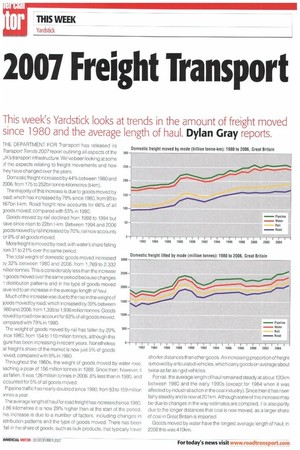2007 Freight Transport
Page 24

If you've noticed an error in this article please click here to report it so we can fix it.
This week's Yardstick looKs at trends in the amount of freight moved since 1980 and the average length of haul. Dylan Gray reports.
THE DEPARTMENT FOR Transport has released its Transport Trends 2007 report outlining all aspects of the UK's transport infrastructure. We've been looking at some Df the aspects relating to freight movements and how :hey have changed over the years.
Domestic freight increased by 44% between 1980 and 2006, from 175 to 252bn tonne-kilometres (t-km).
The majority of this increase is due to goods moved by pad, which has increased by 79% since 1980, from 93 to 167bn t-km. Road freight now accounts for 66% of all goods moved, compared with 53% in 1980.
Goods moved by rail declined from 1988 to 1994 but lave since risen to 22bn t-km. Between 1994 and 2006 goods moved by rail increased by 70%; rail now accounts or 9°/0 of all goods moved.
More freight is moved byroad, with water's share falling ram 31 to 21% over the same period.
The total weight of domestic goods moved increased )y 32% between 1980 and 2006, from 1,769 to 2,332 nillion tonnes. This is considerably less than the increase n goods moved over the same period because changes n distribution patterns and in the type of goods moved lave led to an increase in the average length of haul.
Much of the increase was duetothe rise in the weight of ]oods moved by road, which increased by 39% between 980 and 2006, from 1,395 to 1,936 million tonnes. Goods noved by road now account for 83% of all goods moved. :am pared with 79% in 1980.
The weight of goods moved by rail has fallen by 29% ince 1980, from 154 to 110 million tonnes, although this gu re has been increasing in recent years. Nonetheless ail freight's share of the market is now just 5% of goods loved, compared with 9% in 1980.
Throughout the 1980s, the weight of goods moved by water rose, ?aching a peak of 156 million tonnes in 1988. Since then, however, it as fallen. It was 126 million tonnes in 2006, 8% less than in 1980, and ccounted for 5% of all goods moved.
Pipeline traffic has nearly doubled since 1980, from 83 to 159 million Dr-Ines a year.
The average length of haul for road freight has increased since 1980. ,t 86 kilometres it is now 29% higher than at the start of the period. his increase is due to a number of factors, including changes in istribution patterns and the type of goods moved. There has been fall in the share of goods, such as bulk products, that typically travel shorter distances than other goods. An increasing proportion of freight is moved by articulated vehicles, which carry goods on average about twice as far as rigid vehicles.
For rail, the average length of haul remained steady at about 120km between 1980 and the early 1990s (except for 1984 when it was affected by industrial action in the coal industry). Since then it has risen fairly steadily and is now at 201km. Although some of this increase may be due to changes in the way estimates are compiled, it is also partly due to the longer distances that coal is now moved, as a larger share of coal in Great Britain is imported.
Goods moved by water have the longest average length of haul; in 2006 this was 410km.
































































































































































































